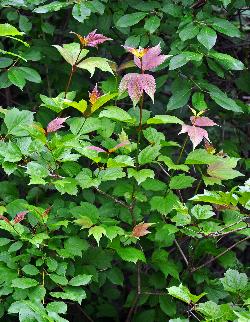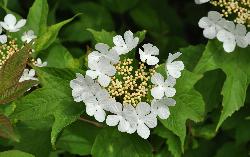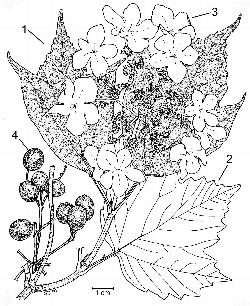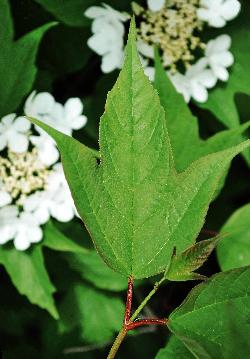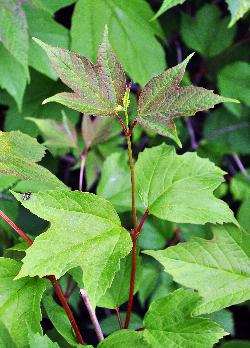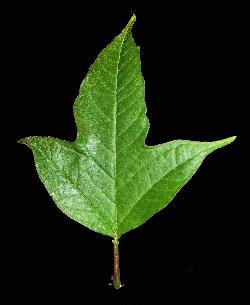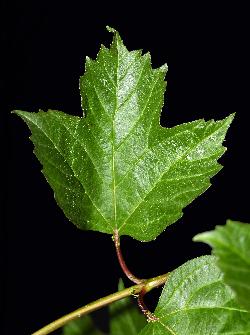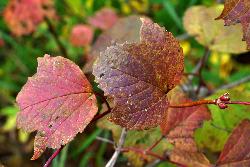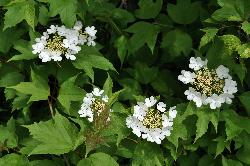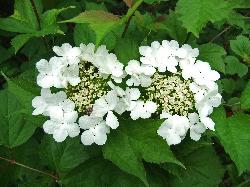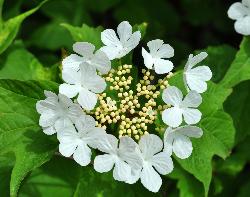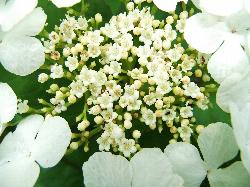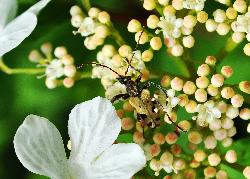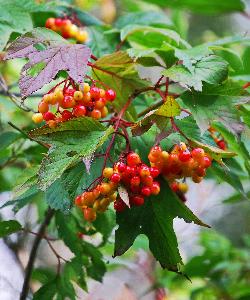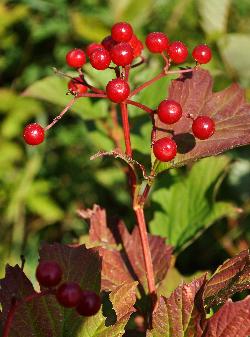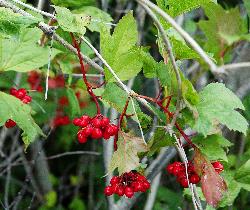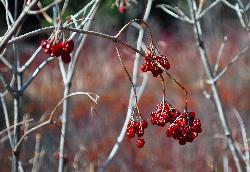Fr: viorne trilobée, quatre-saisons des bois, viorne pimbina, arbuste de pimina
IA: mushuminakashi, mushumin
Viburnaceae - Viburnum Family
Note: Numbers given in square brackets in the text refer to the images presented above; image numbers are displayed to the lower left of each image.
General: A tall deciduous shrub, to about 4 m tall, with attractive white flowers and bright red fruit [1–4]. The berries of highbush cranberry make a delicious jelly or jam, although the cooking berries give off an odour reminiscent of smelly socks, which does not persist in the jelly or jam. Viburnum trilobum has often been classified as a variety or subspecies (var. americanum Aiton, subsp. trilobum (Marshall) R.T. Clausen) of Viburnum opulus L., the Guelder rose. V. opulus is a western Eurasian shrub that closely resembles V. trilobum. Most European botanists also recognize these 2 taxa as distinct species. One important difference between the two is that V. opulus fruits are bitter and mildly toxic, while V. trilobum fruits are edible. In addition to the fertile form of Viburnum opulus, which is often erroneously sold under the name of the native species, sterile cultivars of V. opulus ('Roseum') are available in nurseries under the common name snowball bush. All of the flowers are sterile and have enlarged flat 5-lobed corollas; no fruit are produced by this cultivar.
Key Features: (see numbers indicated on the illustration [5])
- Leaves are opposite, 3-lobed, and resemble maple leaves; newly formed leaves have tapering lobes with entire or slightly toothed margins and acuminate apices.
- Mature leaves have broader lobes with coarsely toothed margins and acuminate to blunt apices.
- The showy inflorescences have marginal flowers with enlarged flat 5-lobed corollas surrounding numerous small fertile flowers with short campanulate corollas.
Stems/twigs: Twigs are glabrous with light brown to greyish bark. Lateral buds are opposite, oblong and blunt, with 2 reddish-brown valvate and connate outer bud scales; leaf scars are broadly V-shaped with 3 vascular trace scars [6–7]. Terminal buds are absent, but new shoots develop from lateral buds at the base of old flowering stalks [8]. Flower buds develop at the end of lateral branches, below old flowering stalks. Mature stems have glabrous, greyish-brown bark.
Leaves: Opposite, simple and 3-lobed, and palmately-veined with 3 main veins [9–10]; the petioles are 1–4 cm long and grooved along the upper surface. One or more pairs of domed or elevated glands occur on the petiole near the leaf blade, while a pair of long thin stipules with thickened clavate tips are attached near the base of the petiole [11]. Leaf blades are 5–11 cm long and wide, glabrous, and dark green above. Young terminal leaf pairs have 3 long-pointed (acuminate) lobes, bases are tapering (cuneate) to nearly round, and blade margins are entire in the sinuses between lobes [12]. Mature leaf blades are ovate to broadly ovate and 3-lobed; the terminal lobe may be triangular to ovate with nearly parallel sides, while the 2 lateral lobes are triangular; leaf bases are rounded to flat (truncate), margins are entire in the sinuses between lobes and coarsely toothed near the acuminate lobe apices [13]. Leaves turn dull reddish-brown in autumn [14].
Flowers: Bisexual; flowers are arranged in large showy flat-topped terminal inflorescences (compound cymes) 4–15 cm across [15–16]. The marginal flowers of the inflorescence are sterile with enlarged flat 5-lobed white corollas [17]. The central fertile flowers [18–19] are small, each with a short campanulate 5-lobed creamy-white corolla, 5 stamens, and an inferior ovary. Flowers bloom in mid-summer. Pollination is by insects (entomophily); beetles were often observed on Viburnum trilobum flowers [20], but pollination is likely accidental, as beetles eat pollen and their effectiveness as pollinators of Viburnum is unknown (van der Pijl 1972).
Fruit: The berry-like fruit (drupes) are reddish-orange when immature, red at maturity, 6–15 mm long, ovoid to nearly spherical, with fleshy and edible although acidic pulp [21–24]. Each drupe contains a single seed inside a flat stony pit. Fruits ripen in late summer and persist overwinter in drooping clusters. During winter, the opaque red fruit gradually become translucent and wrinkled [25]. Dispersal is primarily by frugivorous birds (endozoochory), which regurgitate or defecate the seeds after eating the fruit. In a study by Witmer (2001), he showed that the fruit of V. opulus were preferred by cedar waxwings, who consumed the fruit in April or May after the fruits had overwintered and their sugar concentration had increased. Although Witmer's study was conducted using naturalized populations of V. opulus in central New York, fruits of native V. trilobum are commonly observed still attached to the shrub in the spring.
Ecology and Habitat: Within the province, highbush cranberry occurs throughout the Island of Newfoundland, but is absent from Labrador. It is most frequently encountered in moist nutrient-rich forests, forested fens, and alder swamps along the shorelines of small brooks and rivers. It occurs sporadically under the shade of full canopy closure, but can be abundant in gaps created by blowdown, and can form large patches on burns and cutovers through root sprouting.
Edaphic Grid: See image [26]: the Edaphic Grid for Viburnum trilobum.
Forest Types: Highbush cranberry is most frequently encountered in the following forest types:
- Abietum caricetosum (Carex-Balsam Fir Forest Subassociation)
- Abietum dryopteretosum (Dryopteris-Balsam Fir Forest Subassociation)
- Abietum rubetosum - wet variant (Rubus-Balsam Fir Forest Subassociation - wet variant)
- Alnetum solidagetosum (Solidago-Alder Swamp Subassociation)
- Alnetum typicum (Moist Alder Swamp Subassociation)
Succession: Highbush cranberry is a light-demanding shrub that occurs only in open forest types, such as forested fens and alder swamps. Occasionally, it may form large patches where blowdowns open the canopy on moist nutrient-rich sites. Its abundance can increase rapidly after clearcutting through root sprouting. This can also happen after fire, but fires rarely occur in the wet habitats frequented by highbush cranberry.
Distribution: Highbush cranberry is a north-temperate to southern boreal species found across the Island of Newfoundland, but absent from Labrador. In Canada, its range extends from Newfoundland to British Columbia, but generally occurs south of 52° N latitude (Scoggan 1978). In the United States, its primary range extends from Maine west through New England and the Lake States to the Dakotas.
Similar Species: Squashberry (Viburnum edule (Michx.) Raf.), is the Viburnum species most similar to highbush cranberry, but is a smaller shrub, less than 2 m tall, with leaves that are initially unlobed and elliptic, becoming 3-lobed as they mature. Flowers occur in small terminal cymes on short lateral shoots followed by small clusters of red drupes, similar to those of highbush cranberry. The Guelder rose or snowball bush, Viburnum opulus L., is a European introduction often planted as an ornamental. Fertile European cultivars of V. opulus, also available commercially, have bitter mildly toxic fruit that can cause vomiting and diarrhea if eaten in large quantities; introduced plants can be differentiated from native plants by their petiole traits, which have disk-shaped glands, near the blade, that are depressed in the middle, and at the petiole base, they have long slender stipules that taper to a point.


